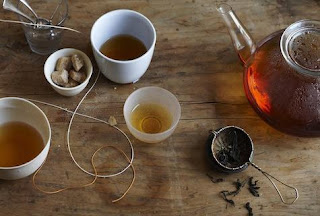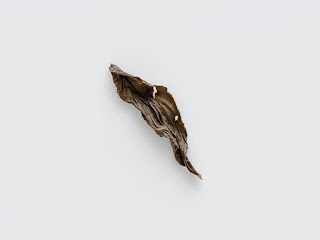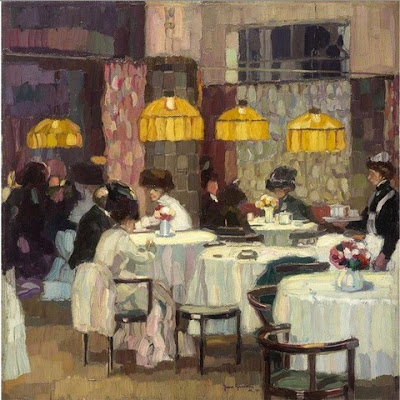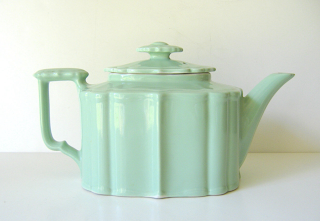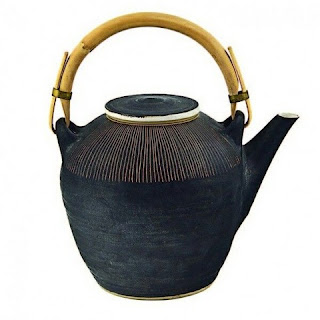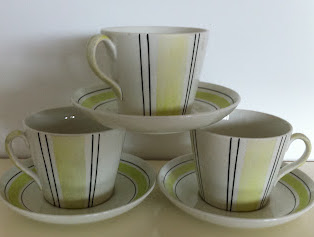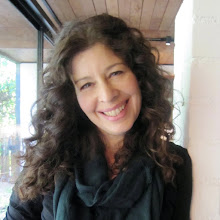Photo: Tony Ray-Jones c. 1967
Tea is what wakes me up every morning, what settles me when I'm anxious and what calms and revives me at the end of the day. I'm not alone in this. Not a surprise that so many cultures have strong tea traditions. Associations with, and rituals around tea are strongly tied to so many places....Japan, China, India, the UK, Turkey, Iran, Morocco, Russia come to mind. Apparently it's the most consumed drink aside from water.The Kinks understand tea...their song Have a Cuppa Tea here.
The drinking of tea (Camellia Sinensis) as a beverage, rather than in a medicinal way (which may have been as early as 2737 BC) started in Southern China, between about 420 and 589. In the Tang Dynasty (618-907) it became emblematic of sophistication. The 8th century author Lu Yu, known as the sage of tea wrote a treatise on the art of drinking tea, "The Classic of Tea", and it's still in print.
Above: An illustration from a book published in 1851 depicts the cultivation of tea in China.
Above: Tea Room in Fuzhou, China, 1890.
Photo: Lai Afong
Above: Women sorting tea, China
Above: Green tea factory, China
Photographer unknown, 1890
Above: Photo of the Japanese tea ceremony.
The first contact the Japanese had with tea was probably in the 8th century when diplomatic missions were sent to China. In 805 a Buddhist monk, Saicho, is thought to have brought tea seeds to Japan. It was enjoyed by the nobility, but didn't spread to the larger population till the late 12th century when large scale plantations were developed.
The first tea rooms were created in the late 15th century. The ritual of the tea ceremony was formalized by Sen-no- Rikyu (1522-1591). He is the tea master who commissioned the first "Wabi" tea room. Wabi Sabi is a world view that embraces transience and imperfection. This first wabi tea room had mud walls and a thatched roof, and was far from the luxurious tea rooms that had been in fashion previously. Rikyu's iconic rustic tea house is a model for many tea houses to this day.
Above: The entrance to the tea house is small, forcing the guest to humble themselves by bending low to enter.
Rikyu commissioned teabowls from Chojiro who produced the first Raku ware, hand built, irregular in shape, and fired quickly in a way to encourage uncontrolled finishes. Chojiro's descendants have consecutively, generation after generation, taken on the mantle of Raku master. When we were in Kyoto we were lucky enough to meet the current Raku master, Kichizaemon XV.
Above and below: Tea fields, Shizuoka, Japan. You can see Mt. Fuji in the background. One of the oldest fields, green tea was first planted here in the 13th century.
Above: Vintage illustration of tea, clippers, and tea basket.
Above: Sen-no-Rikyu designed this tea room, Tai-an, at the Myoki-an temple, Kyoto, in 1582.
Above: In this floor plan of a tea house each section is the size of a tatami mat.
Above: Tea room at Daitoku-ji temple, designed by Sen-no-Rikyu.
Rikyu commissioned teabowls from Chojiro who produced the first Raku ware, hand built, irregular in shape, and fired quickly in a way to encourage uncontrolled finishes. Chojiro's descendants have consecutively, generation after generation, taken on the mantle of Raku master. When we were in Kyoto we were lucky enough to meet the current Raku master, Kichizaemon XV.
Above: This teabowl is made by Raku Kichizaemon, Raku master XV.
Above: The Book of Tea, by Okakura Kakuzo. Written in 1906, the Book of Tea is a long essay linking the role of tea to the aesthetic and cultural aspects of Japanese life, intended for reading by a western audience.
Above and below: The simplicity of the tea house concept has made it a rich subject for architectural experimentation, for a sculptural approach to design. Architect Tadao Ando described Japanese tea houses as containing "an infinitely expanding universe in an enclosed very small space". This tea house is designed by Czech studio A1 Architects.
Above and below: Oribe Tea House, designed by Kengo Kuma. It's a temporary structure made of corrugated plastic bands which can be dissembled and transported. This was set up at Design Miami in 2015.
Above and below: This remarkable tea house designed by Kazuhiro Yajima, is made from one piece of bamboo. It was split into 50 ribs radiating from a central hub like an umbrella, wrapped in rice paper. It can be folded up like an umbrella for transport.
Photo: Satoshi Shigeta
Above and below: Steel tea house by KS-Architects, Osaka
Above: "Tea Garden", from a sample calendar made by Empire Calendar Manufacturing Company, Calcutta, 1940s.
Photo: Brett Cole
Above: Known as the King of Tea, Swaraj Kumar Banarjee samples his teas in Darjeeling.
Photo: Resham Gellatly
Above: A chai set up at a train station
Above: Tea stall vendor, Raju Ninawe, at the Sai Baba temple in Nagpur, India.
Photo: Reshlam Gellaty
Above: Bishwanath Ghosh has been pouring tea at Kolkata's Ghosh Cabin for over 40 years.
Photo: Resham Gellaty
Above: Clay cups, quickly made, and low fired, are disposable. Some are even made by the chai wallahs in a small kiln next to their stand. After finishing the tea, the cup is thrown into the gutter and crushed and washed away with the rains, to go back to the earth.
Above: Preparing tea in one of the oldest tea houses in Sichuan, China in the town of Pengzhen.
Above: Another view of the Pengzhen tea house.
Photo: Matsumoto
Above: Chinese tea ceremony
Above: Preparing tea in Tokyo, near Omotesando at Shinya Sakurai's Japanese Tea Experience.
Above and below: At Bellocq in Brooklyn, NY.
Above: In San Francisco at Samovar Tea Lounge.
Above: Wide selection of teas at La Maison des Trois Thes, Paris.
Photo: Daniel Dent
Above and below: Making matcha tea, instructions from Leaves and Flowers. You can read about making matcha tea here.
Photo: Daniel Dent
Above: Uplifters Ceramics tea bowl
Photo: Dalilah Arja
Above and below: Song Tea & Ceramics in San Francisco. Owner Peter Luong below. He aims to create "an elegant environment for sampling and purchasing vibrant high quality teas that are handpicked and crafted and sourced in small batches". More on Song Tea here and here.
Photo: Cindy Loughridge for sfgirlbybay
Photo: Dalilah Arja
Above: From Song Tea, Jade Dew green tea from Sichuan, China, organic. These leaves were handpicked over 4 days starting March 25th 2017. The leaves were withered, steamed to set, fan dried, fired twice, and shaped. This tea's origins can be traced back to the 12th century.
Above: From Song Tea, Old Tree Yunnan red tea from Yunnan, China. These leaves were picked in April 2017, then shade withered, bruised, oxidized, and pan roasted in small batches. It was then wrapped in canvas and roasted over charcoal. I tried some of this tea and it really has a wonderful flavor. Red tea is what we call black tea in the west.
Above: From Song Tea, Aged Baozhong. This is an oolong tea, and has been aging in a ceramic urn since the 1960s.
Above: Demonstration by Ippodo Tea.
Here's a great song about tea. It's "Everything Stops for Tea" from the 1935 musical "Come Out of the Pantry", performed by Jack Buchanan. Though sounding very British it was written by 3 New Yorkers...music by Maurice Sigler, with lyrics by Al Goodheart and Al Hoffman.
Above: Edmund Marion Ashe (1867-1941), Pot of Tea and Ice Cream
Above: Lyons "Nippy" Waitress c. 1930. She would have worked in one of the Lyons tea shops or restaurants in London. They introduced this uniform in 1925. The nickname came from the speed at which they worked, nipping in between tables serving customers.
Above: Basil Rathbone as Sherlock Holmes and Nigel Bruce as Watson with their tea.
Above: As part of the P.G. Tips campaign, these two chimpanzees are drinking tea at Twycross Zoo in the 1960s. They were used in ads from 1956 for about 30 years, lip synching with voices by performers such as Peter Sellers and Cilla Black. Their caretaker, Molly Badham made enough from the campaigns to purchase 22 acres in Twycross and open the zoo in 1963.
Above: Tea break on a hike.
Above: A cup of tea comforts in the direst of times.
During WWII many photos were taken of British soldiers drinking tea. Something about the comfort and familiarity of tea, the sense of it making an island of normalcy and safety in a dangerous world, that made for an enormous number of images documenting the serving and drinking of tea. Tea was also seen as an energy booster, something useful to the troops.
Above: A mobile tea canteen at the front in North Africa, 1942.
Above: A wounded soldier with his cup of tea aboard a hospital train, Normandy, 1944.
Above: Troops evacuated from Crete being served tea at an Egyptian port, 1941.
Above: Evacuated troops receive tea at a London train station, 1940.
Above: Members of the ATS have tea in London, 1945.
Above: An ad in the Hindustan Times c. 1940s.
Above: This poster, "Tea Drives Away the Droops" was designed in 1936 by Edward McNight Kauffer for the Empire Tea Market-Expansion Board. Collection Cooper Hewitt.
Above: 1960s ad for tea, endeavoring to promote tea with dinner. The energy boosting effects are clearly working on the model!
Photo: Jerry Johnson
Above: This former gas station built in the shape of a teapot was intended as a reminder of the Teapot Dome Scandal involving Warren G. Harding and Interior Secretary Albert Fall. It's located in Zillah, Washington and listed on the National Register of Historic Places.
Above: This giant tea kettle was created in 1875 as a promotional stunt for the Oriental Teashop in Boston. It is still hanging today above a Starbucks location nearby. When it was created there was a contest to guess the capacity...it holds 277 gallons of tea.
Above: On a smaller scale, this stainless steel tea kettle was designed by Sori Yanagi in 1994.
Above: A modification of the traditional English kettle, made by Another Country.
Above: Vintage copper tea kettles
Above: Antique Japanese tetsubin iron teapot kettle
Above: Tetu Cast Iron Kyusu Teapot from Nalata Nalata, NYC
Above: Kaiko Kettle by Makoto Koizumi available at Nalata Nalata, NYC.
Above: Advertising illustration by Anne Taintor
Above: "Friends", from a calendar made by Empire Calendar Manufacturing Company, Calcutta, 1940s. The ritual of drinking tea with a friend encourages intimate conversations as shown in a number of these paintings.
Above: Mary Cassatt (1844-1926), Afternoon Tea Party, 1890-91. Collection Metropolitan Museum, NY.
Above: Mary Cassatt, The Tea, 1880. Collection MFA, Boston
Above: Mabel Frances Layng (1881-1937), The Tea Table. Collection West Park Museum, Cheshire.
Above: Elizabeth Taylor and James Dean in Giant, 1955.
Above: At an outdoor teahouse in Chengdu reading a newspaper, and drinking tea.
Photo: Jim Marshall
Above: Bob Dylan having tea with a cat, Greenwich Village, 1963.
Above: Cary Grant drinking tea on set.
Above: Peter Sellers in the Pink Panther, 1963.
Above: The Beatles drinking tea, 1964.
Photo: Henry Grossman
Above: The Supremes, drinking tea.
Above: Photo of four women on a bench drinking tea, 1974, England.
Above: Tea at the Savoy, 1924
Above: A gathering of women at one of the outdoor teahouses in Chengdu, capital of Sichuan province. More photos here.
Photo: Max Penson
Above: Uzbekistan tea party. More about the photographer, Max Penson (1893-1959), here.
Above: Tea at a picnic circa 1900.
Above: Sophia Loren
Above: Dalai Lama
Above: Konstantin Makovsky (1839-1915), Drinking Tea
Above: Russian family gathered around a samovar for tea. Found in a book by Mickael Bulgatav.
Above: Anastasia Hohriakova, Tea Drinking, 2000
Above: Frederick Carl Frieseke (1874-1939), Afternoon Tea on the Terrace.
Above: Henri Matisse (1869-1954), Tea, 1919
Above: Henri Matisse, Woman Reading
Above: My husband's sketch of me holding my mug of tea.
Above: Gwen John (1876-1939), The Brown Tea Pot
Above: Georges Lemmen (1865-1916), Tea (also known as Madame Georges Lemmen), 1902
Above: Drinking "noon chai" made from milk, pistachios, almonds, and spices, in Pakistan.
Above: A woman drinking chai, Uttar Pradesh, India
Above: Leon de Smet (1881-1966), The Red Table
Above: Andy Warhol
Above: Edwin Howland Blashfield (1848-1936), Tea Time
Photo: Lindsay Brown
Above: Afternoon chai in the main bazaar, Mandawa, Rajasthan, India
Above: Josse Goossens (1876-1929), At the Tea Bar
Above: Yellow tea kettle
Above: Vintage 1940s Hall Genie Aladdin black and gold teapot
Above: Vintage 1940s Hall Victorian line, "Benjamin" celadon green teapot
Above: Wedgwood and Sons tea and coffee pot, 1867, collection V and A.
Above: Stacking Tea Service made by Gabbianelli, 1970. Molded and glazed earthenware and metal. Collection Cooper Hewitt
Above: The "Brown Betty" teapot. After the popularization of tea in Britain, local potters started producing this teapot design in about 1695. They used local red clay from Staffordshire, home to Wedgwood and Minton, to make these pots. The pots are still made from the local red clay. The shape of the pot causes the leaves to be gently swirled as the water pours in. This pot was made in Stoke on Kent.
Above: Teapot made by Lucie Rie, with manganese glaze, 1958.
Above: Pot by Ogata Kenzan (1663-1743)
Above: Silver Teapot, William Smily, London, 1858.
Above and below: Vintage silver tea infusers.
Above: Janet Fish, Herb Tea, 1995
Above: Anne Redpath, Still Life with Teapot on Round Table, 1945
Above: Anne Redpath, Still Life with Cup and Saucer
Above: Afternoon tea at The Brink in Liverpool.
Above: Carl Larsson, Holiday Reading, 1916
Doll tea parties are a classic theme in kids play. There are a couple of those scenes below by iconic children's illustrators, and one staged photo with a well behaved dog at the tea table.
Above: Jessie Wilcox Smith, In a Closed Room, 1901
Above: Cicely Mary Barker, The Doll's Tea Party
Above: Vintage postcard
Above: John Teniel's illustration from Alice in Wonderland, The Mad Hatter's Tea Party, 1865.
Above and below: Inspired by the "Unbirthday Party" scene in Alice in Wonderland, this is a photo of the Mad Tea Party ride at Disneyland, circa 1962, above, and from 1957 below.
Photo: Romain Veillon
Above: Tea Cup ride from Japan's abandoned Nara Dreamland theme park.
Above: Maira Kalman tea cup drawing, illustrating a few lines from Alice in Wonderland. This can be found in her book "My Favorite Things".
Above: Maira Kalman, tea cup from her NYTimes blog "And the Pursuit of Happiness".
Above and below: Mary Elizabeth's Tea Room menu. The first tea room opened on 5th Avenue in NY in 1915, and soon there were branches in Newport and Boston.
Above: Mulberry transfer ware cup and saucer by Crown Ducal in Tunstall, Staffordshire, in the Bristol pattern, made between 1931 and 1937.
Above: Swedish tea cups, possibly Stig Lindberg
Above: Pink 1830s Sunderland Lusterware tea cup.
Above: Bright yellow Melaware tea cups and saucers, 1950s.
Above: Striped Cup, Blue, Thin White, from Nalata Nalata
Above and below: 20th century ceramics from Gzehl, Russia. Painted on the tea pot above is a woman drinking tea served from a samovar.
Above: Ceramic tea cups made from originals by J.B. Blunk, available here. Blunk's daughter Mariah Nielson produces them from cups he made 1950-1990, and they're recreated in white porcelain by Atelier Dion in Oakland.
Photo: Fredrik Nilsen








































